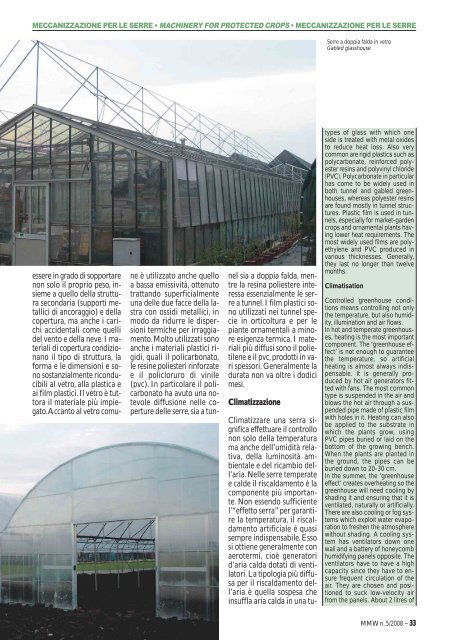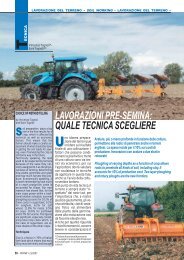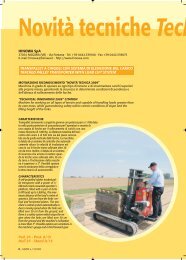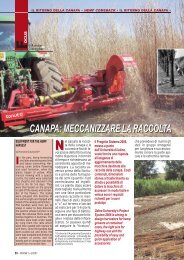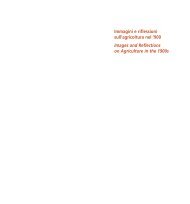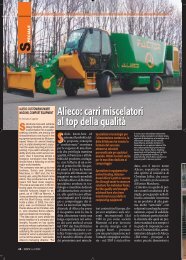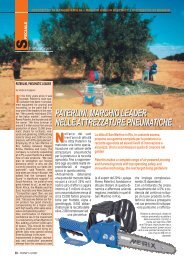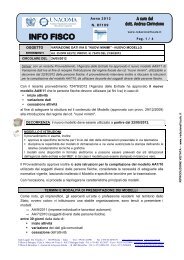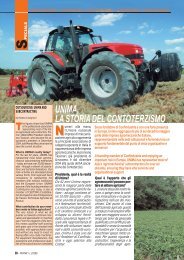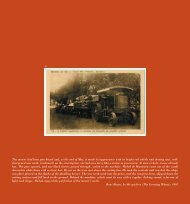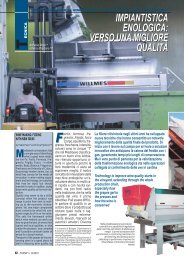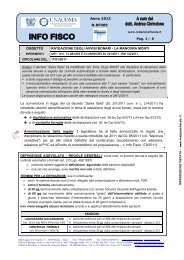tipologie di serre e tecniche di coltivazione - FederUnacoma
tipologie di serre e tecniche di coltivazione - FederUnacoma
tipologie di serre e tecniche di coltivazione - FederUnacoma
Create successful ePaper yourself
Turn your PDF publications into a flip-book with our unique Google optimized e-Paper software.
MECCANIZZAZIONE PER LE SERRE • MACHINERY FOR PROTECTED CROPS • MECCANIZZAZIONE PER LE SERRE<br />
essere in grado <strong>di</strong> sopportare<br />
non solo il proprio peso, insieme<br />
a quello della struttura<br />
secondaria (supporti metallici<br />
<strong>di</strong> ancoraggio) e della<br />
copertura, ma anche i carichi<br />
accidentali come quelli<br />
del vento e della neve. I materiali<br />
<strong>di</strong> copertura con<strong>di</strong>zionano<br />
il tipo <strong>di</strong> struttura, la<br />
forma e le <strong>di</strong>mensioni e sono<br />
sostanzialmente riconducibili<br />
al vetro, alla plastica e<br />
ai film plastici. Il vetro è tuttora<br />
il materiale più impiegato.Accanto<br />
al vetro comu-<br />
ne è utilizzato anche quello<br />
a bassa emissività, ottenuto<br />
trattando superficialmente<br />
una delle due facce della lastra<br />
con ossi<strong>di</strong> metallici, in<br />
modo da ridurre le <strong>di</strong>spersioni<br />
termiche per irraggiamento.<br />
Molto utilizzati sono<br />
anche i materiali plastici rigi<strong>di</strong>,<br />
quali il policarbonato,<br />
le resine poliesteri rinforzate<br />
e il policloruro <strong>di</strong> vinile<br />
(pvc). In particolare il policarbonato<br />
ha avuto una notevole<br />
<strong>di</strong>ffusione nelle coperture<br />
delle <strong>serre</strong>, sia a tun-<br />
nel sia a doppia falda, mentre<br />
la resina poliestere interessa<br />
essenzialmente le <strong>serre</strong><br />
a tunnel. I film plastici sono<br />
utilizzati nei tunnel specie<br />
in orticoltura e per le<br />
piante ornamentali a minore<br />
esigenza termica. I materiali<br />
più <strong>di</strong>ffusi sono il polietilene<br />
e il pvc, prodotti in vari<br />
spessori. Generalmente la<br />
durata non va oltre i do<strong>di</strong>ci<br />
mesi.<br />
Climatizzazione<br />
Climatizzare una serra significa<br />
effettuare il controllo<br />
non solo della temperatura<br />
ma anche dell’umi<strong>di</strong>tà relativa,<br />
della luminosità ambientale<br />
e del ricambio dell’aria.<br />
Nelle <strong>serre</strong> temperate<br />
e calde il riscaldamento è la<br />
componente più importante.<br />
Non essendo sufficiente<br />
l’“effetto serra” per garantire<br />
la temperatura, il riscaldamento<br />
artificiale è quasi<br />
sempre in<strong>di</strong>spensabile. Esso<br />
si ottiene generalmente con<br />
aerotermi, cioè generatori<br />
d’aria calda dotati <strong>di</strong> ventilatori.<br />
La tipologia più <strong>di</strong>ffusa<br />
per il riscaldamento dell’aria<br />
è quella sospesa che<br />
insuffla aria calda in una tu-<br />
Serre a doppia falda in vetro<br />
Gabled glasshouse<br />
types of glass with which one<br />
side is treated with metal oxides<br />
to reduce heat loss. Also very<br />
common are rigid plastics such as<br />
polycarbonate, reinforced polyester<br />
resins and polyvinyl chloride<br />
(PVC). Polycarbonate in particular<br />
has come to be widely used in<br />
both tunnel and gabled greenhouses,<br />
whereas polyester resins<br />
are found mostly in tunnel structures.<br />
Plastic film is used in tunnels,<br />
especially for market-garden<br />
crops and ornamental plants having<br />
lower heat requirements. The<br />
most widely used films are polyethylene<br />
and PVC produced in<br />
various thicknesses. Generally,<br />
they last no longer than twelve<br />
months.<br />
Climatisation<br />
Controlled greenhouse con<strong>di</strong>tions<br />
means controlling not only<br />
the temperature, but also humi<strong>di</strong>ty,<br />
illumination and air flows.<br />
In hot and temperate greenhouses,<br />
heating is the most important<br />
component. The ‘greenhouse effect’<br />
is not enough to guarantee<br />
the temperature, so artificial<br />
heating is almost always in<strong>di</strong>spensable.<br />
It is generally produced<br />
by hot air generators fitted<br />
with fans. The most common<br />
type is suspended in the air and<br />
blows the hot air through a suspended<br />
pipe made of plastic film<br />
with holes in it. Heating can also<br />
be applied to the substrate in<br />
which the plants grow, using<br />
PVC pipes buried or laid on the<br />
bottom of the growing bench.<br />
When the plants are planted in<br />
the ground, the pipes can be<br />
buried down to 20-30 cm.<br />
In the summer, the ‘greenhouse<br />
effect’ creates overheating so the<br />
greenhouse will need cooling by<br />
sha<strong>di</strong>ng it and ensuring that it is<br />
ventilated, naturally or artificially.<br />
There are also cooling or fog systems<br />
which exploit water evaporation<br />
to freshen the atmosphere<br />
without sha<strong>di</strong>ng. A cooling system<br />
has ventilators down one<br />
wall and a battery of honeycomb<br />
humi<strong>di</strong>fying panels opposite. The<br />
ventilators have to have a high<br />
capacity since they have to ensure<br />
frequent circulation of the<br />
air. They are chosen and positioned<br />
to suck low-velocity air<br />
from the panels. About 2 litres of<br />
MMW n. 5/2008 – 33


